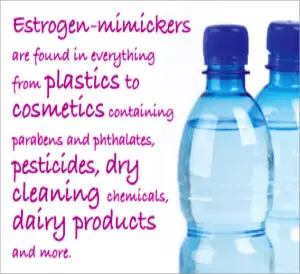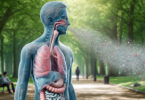Contributing Writer for Wake Up World
I haven’t met an adult yet who doesn’t experience some sort of hormonal imbalances. The fact that most conventionally trained doctors fail miserably in this area and are not able to detect and correctly address such imbalances, makes it even more widespread.
What is really happening? People started to wake up to the reality that much has to do with our lifestyle and dietary choices. But it’s also another, less talked about aspect: environmental exposure to chemicals. And this affects us all to some degree.
Since the end of World War II, some 100,000 synthetic chemicals, pollutants (waste products), and toxicants (such as pesticides and herbicides) have been released into our air, water, or soil. Of the 1000 or more different substances manufactured and released into the environment each year, most are not tested for safety.
Depending on where you live, either some or many of these compounds are in the food you eat, the water you drink, and the air you breathe. These chemicals have the power to disrupt the endocrine system, leading to harmful health effects. They are “endocrine disruptors”.
So it is clear that no human has been born since the middle of the 20th century without some exposure, in the womb, to hormonally-active synthetic compounds. This is a reality which we shouldn’t deny, but rather gather information on how to cope with.
How Do Xenoestrogens Affect Our Health?
Today, the list of hormonally active compounds is longer than anyone had previously imagined in the early days of the research. Not only are more compounds involved, but more hormone systems are now known to be vulnerable. And within each hormonal system, new mechanisms of interaction between compounds and receptor systems are being explored to understand how a compound exerts its effects.
Originally framed only as “estrogen mimicry” or “estrogens in the environment,” research has expanded to include many other hormone systems: estrogen blocking as well as mimickry, androgen blocking, concern for interference with thyroid hormones and progesterone.
Estrogen mimickers in the form of chemicals (xenoestrogens) mimic the action of estrogen produced in cells and can alter hormonal activity. It should be of particular interest for anyone dealing with an estrogen dominance already (very common for many women these days) and related conditions such as uterine fibroid tumors, fibrocystic breasts, breast cancer, glandular dysfunction, male infertility, endometriosis, hair loss, weight gain, and depression, to name just a few.
Estrogen dominance from these environmental hormone disrupters are causing an imbalance of female hormones, creating a host of estrogen dominance symptoms.
Girls and boys are reaching puberty too early as a result of these disrupters. Additionally, xenoestrogens produce hormonal stimuli that contributes to inappropriate growth of mammary tissue cells, resulting in a problem society is calling “man boobs.”
Hormones – most of which are created in various glands such as the thyroid- act in the body like messengers, to transfer information from glands to receptor sites in cells. When hormones circulate in our blood, they are seeking the right site on our cells to plug into so that their message can be both send and received by our cells and body. When the connection is made, estrogens and other hormones are meant to start and stop a wide range of physiological functions. Hormones are not selective. So instead of “partnering” with their meant-to-be-hormone, they also accept a wide variety of synthetic hormone-like strangers into their receptor sites, blocking the message of the naturally occuring hormone. In addition, because these synthetic hormones are constantly present, they may attach at the wrong time and disrupt the precise timing of the developmental order.
In her book Hormone Deception, Lindsey Berkson identifies at least five different responses that can occur when “inappropriate orders” are given by synthetic hormones:
- mimic the natural hormones in our bodies, such as estrogens
- antagonize (block) our natural hormones, such as androgens (male hormones), thyroid hormone, and progesterone
- alter the way in which natural hormones are produced, eliminated or metabolized
- modify the number of hormone receptors we have and thus the amount of hormonal signaling in our bodies
- stimulate the release of hormones or other natural substances that affect the balance of our hormones in our bodies
Where Can Endocrine Disrupting Xenoestrogens Be Found?
The most common endocrine disruptors are:
- Atrazine – is widely used as an herbicide to control broad-leaf weed species that grow in crops such as corn, sugarcane, hay and winter wheat. Atrazine is also applied to Christmas trees, residential lawns, golf courses, and other recreational areas. Atrazine is the second largest selling pesticide in the world and estimated to be the most heavily used herbicide in the United States.
- BPA – used as a lining in most food and beverage cans. BPA global capacity is in excess of 6.4 billion lbs per year and thus is one of the highest-volume chemicals produced worldwide. Leaching of BPA has led to widespread human exposure.
- Butylated hydroxyanisole, BHA is used as a food preservative.
- Bisphenol A is monomer for polycarbonate plastic and epoxy resin; antioxidant in plasticizers.
- Dioxin is a group of highly toxic chemicals are released during combustion processes, pesticide manufacturing and chlorine bleaching of wood pulp. Dioxin is discharged into waterways from pulp and paper mills.
- Erythrosine, FD&C Red No. 3 used in a wide range of processed foods and medications.
- Ethinylestradiol (combined oral contraceptive pill) is released into the environment as a xenoestrogen.
- Endosulfan is an insecticide used on numerous vegetables, fruits, cereal grains and trees. Human exposure occurs through food consumption or ground and surface water contamination.
- Nonylphenol and derivatives are used as industrial surfactants, emulsifiers for emulsion polymerization, laboratory detergents, pesticides.
- PBB are chemicals added to plastics used in computer monitors, televisions, textiles and plastics foams to make them more difficult to burn. Manufacturing of PBBs in the United States stopped in 1976, however because they do not degrade easily PBBs continue to be found in soil, water and air.
- PCBs are man made organic chemicals known as chlorinated hydrocarbons. PCBs were manufactured primarily for use as insulating fluids and coolants given their chemical stability, low flammability and electrical insulating properties. PCBs were banned in 1979 but like DDT continue to persist in the environment.
- Phthalates are plasticizers providing durability and flexibility to plastics such as polyvinyl chloride. High molecular weight phthalates are used in flooring, wall coverings and medical device such as intravenous bags and tubing. Low molecular weight phthalates are found in perfumes, lotions, cosmetics, varnishes, lacquers and coatings including timed releases in pharmaceuticals.
- Parabens are used in a huge variety of cosmetics, and personal care products.
- Propyl gallate is used to protect oils and fats in products from oxidation.
- 4-hexyl resorcinol is used to prevent shrimp, lobsters, and other shellfish from discoloring.
- 4-Methylbenzylidene camphor (4-MBC) is used in sunscreen lotions.
A Few Important Ways To Reduce Xenoestrogens In Your Life
Environment and house
- Organ chlorines, are one of the largest sources. They are found in pesticides, dry cleaning, bleaching of feminine-hygiene products and the manufacture of plastics. Choose organic feminine hygiene products and avoid the rest.
- Avoid plastic goods – they leach into the environment and will eventually come right back to your plate.
- Avoid new carpet – it can give off noxious fumes.
- Be aware of noxious gas such as that from copiers and printers, carpets, fiberboards, etc.
- Do not inhale and protect your skin from: electrical oils, lubricants, adhesive paints, lacquers, solvents, oils, paints, fuel, industrial wastes, packing materials, harsh cleaning products, fertilizers.
- Avoid all pesticides, herbicides, and fungicides on produce. Wash the fruits and vegetables in a solution of one part vinegar and 3 parts water before consuming, to rid the pesticides.
- Have a good water filterfor your source of water. Reverse osmosis is the best option. Do not leave plastic containers, especially your drinking water, in the sun. If a plastic water container has heated up significantly, throw it away – do not drink the water either.
- Use only organic based whole foods. Buy organic, pastured, hormone free, antibiotic free meats and dairy products, ideally from small, sustainable farmers.
- Propyl gallate, the preservative used to prevent fats and oils from spoiling can be found in a range of foods including baked goods, shortening, dried meats, candy, fresh pork sausage, mayonnaise and dried milk.
- Do not microwave food in plastic containers, and especially avoid the use of plastic wrap to cover food for microwaving.
- Use glass or ceramics whenever possible to store food.
- The birth control pill contains high concentration of synthetic estrogen. Choose a condom or diaphragm gels without surfactants. Use a condom without spermicidal.
- Don’t use hormone replacement therapy (HRT).
- Avoid X-rays as much as possible.
Personal care products and cleaning
- Don’t use fabric softeners as it puts petrochemicals right on your skin.
- Use a simple laundry and dish detergent with less chemicals.
- Buy non-toxic house cleaners like Seventh Generation or make your own, using basic and effective ingredients like vinegar, lemon, baking soda, and borax.
- Use organic soaps and toothpastes. Avoid fluoride.
- Avoid creams and cosmetics that have toxic chemicals and estrogenic ingredients such as parabens and stearal konium chloride. Switch to more natural and simple products. Cheap brands usually have more toxic ingredients. To check the level of toxicity for your cosmetics you can go to ewg.org/skindeep. Better yet, you can make your own, non-toxic (even edible!) personal care products, using essential oils, organic oils and other basic ingredients. The simpler, the better!
- Avoid regular nail polish and nail polish removers. At health food stores and online you can find non-toxic alternatives for these.
- Use only naturally based perfumes, like Pacifica. Most perfumes are petrochemically based.
Address Your Hormonal Imbalances Naturally
Hormones affect metabolic processes and have many, very powerful effects and will result in change in metabolism, mood, weight, fluid balance, to name just a few. The adrenals and the steroidal hormone balance are involved in regulating virtually every aspect of body function!
The Adrenal Cortex, for example, is responsible for producing over 50 different types of hormones. Simply put: As goes the health and functional efficiency of the adrenals, so goes the health and functional efficiency of every aspect of metabolism in the body.
The biggest insult for our bodies when we want to balance our hormones is to choose hormone replacement therapy. This contains synthetic estrogens, which have been clearly associated with a significant increase in breast cancer. Moreover, this allopathic and dangerous approach doesn’t even come close to address the real cause of hormonal imbalances.
A holistic, integrative and functional approach that is meant to give your body all necessary nutrients in order to start producing hormones as needed and maintain optimal levels is offered by the Functional Diagnostic Nutrition Advisors. They are highly trained to address your hormonal imbalances in a very effective, non-invasive and safe way.
And the best rule of all: LIVE A SIMPLE, “GREEN” LIFE AND STICK WITH QUALITY AND LESS QUANTITY IN EVERYTHING! Read labels and make your own whenever you can. This should offer a great deal of improvement in your quality of life!
Resources:
http://www.ourstolenfuture.org/newscience/ubiquitous/ubiquitous.htm
http://www.environmentalhealthnews.org/ehs/news/estrogenic-food-additives
Berkson, Lindsey. Hormone Deception
Gray Graham, Deborah Kesten and Larry Scherwitz. Pottenger’s Prophecy-How Food Resets Genes For Wellness Or Illness
T. Colborn, D. Dumanoski, and J. Peterson, Our stolen future. New York: Penguin, 1997
http://en.wikipedia.org/wiki/Xenoestrogen
Recommended articles by Raluca Schachter:
- Vitamin D Supplementation: This is Why It Can Be Wrong
- Hypothyroidism or Hashimoto’s? What You Need to Know and Why It Matters
- Understanding Cannabis Oil
- 6 Steps to Solve Your Blood Sugar Problems Permanently
- Antibiotic Resistant Infections: The Dangers… and How You Can Avoid Them
- What Really Happens When You Take Antibiotics?
- Understanding Inflammation and How to Eliminate It Naturally
- Listen to Your Body. Correct Food Ratios. Reverse Disease.
- Cholesterol Myths Debunked
- Follow The Money In “Sick-Care”: What’s Behind The Drugs And Needles?
- What Happens In Your Body When You Suffer From Thyroid Disease?
About the author:
 Raluca Schachter is a dedicated Clinical Nutritionist / Natural Health Practitioner a.k.a “The Health Detective”. Raluca was able to naturally reverse chronic health conditions she was struggling with most of her life, and now uses her knowledge to help as many people as possible do the same. Her health programs and diet plans offer a very unique and comprehensive approach to health, where individual nutritional and biochemical requirements are firstly met using specific nutrients and foods that each metabolism thrives on. Raluca offers her services to international clientele and her practice is fully online based. You can connect with Raluca at www.metabolicenergy.net and https://www.facebook.com/raluca.schachter.metabolicenergy
Raluca Schachter is a dedicated Clinical Nutritionist / Natural Health Practitioner a.k.a “The Health Detective”. Raluca was able to naturally reverse chronic health conditions she was struggling with most of her life, and now uses her knowledge to help as many people as possible do the same. Her health programs and diet plans offer a very unique and comprehensive approach to health, where individual nutritional and biochemical requirements are firstly met using specific nutrients and foods that each metabolism thrives on. Raluca offers her services to international clientele and her practice is fully online based. You can connect with Raluca at www.metabolicenergy.net and https://www.facebook.com/raluca.schachter.metabolicenergy

If you've found value in our articles, we invite you to support the release of our brand-new book, "Gratitude Practices for Kids: A Practical Guide for Adults to Instill a Spirit of Appreciation and Positivity in the Next Generation."
"Gratitude Practices for Kids" brings together over 25 innovative and accessible practices designed to enhance gratitude in everyday life. This comprehensive guide is backed by 17 scientific studies, ensuring each concept is grounded in research, underscoring our commitment to nurturing growth, emotional intelligence, and positive interactions between adults and children.
We encourage you to opt for the paperback version to celebrate this new release. Dive into its fresh pages away from digital distractions, allowing you to immerse yourself in the transformative practices it offers.
Over recent years, Wake Up World has faced significant online censorship, which has impacted our financial ability to operate. Moving into book publishing represents a strategic step to secure the ongoing funds needed to continue our mission. By purchasing Gratitude for Kids, you help us keep our content free and accessible to everyone, avoiding needing a paywall. With over 8,500 articles published in the last 13 years, we remain dedicated to keeping our valuable content open to all.








